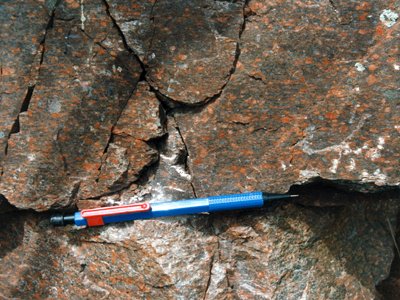Earth Science Conservation Review
| Altmore Burn | Antrim |
| Site Type: | Cliff, Coastal section |
| Site Status: | ESCR |
| Grid Reference: | D233398 |
| Google maps: | 55.19035,-6.06399 |
| Rocks | |
|---|---|
| Rock Age: | Precambrian (Dalradian) |
| Rock Name: | Altmore Formation, Leckpatrick Green Beds, Southern Highlands Group |
| Rock Type: | Green beds, Grit, Psammite |
| Interest | |
| Other interest: | fault |
Summary of site:
This deeply incised stream section is carved into late Precambrian rocks of Upper Dalradian age. These are ancient rocks, over 570 million years old, formed at a time when there were almost no organisms with shells or skeletons capable of forming fossils. All these rocks have been regionally metamorphosed, which means that they have been deeply buried and subjected to high pressures and temperatures that have changed both their appearance and their mineral content.
The Altmore rocks occur at the base of the Southern Highland Group, better known and described in Scotland (see Table). They consist of recognisable grits and quartz-rich bands formed in thick beds, some with well-formed, large feldspar crystals, with green beds lying on top of them. The green beds could be part of the Leckpatrick Green Beds (see Table) but there is no proof of this. These rocks have been much disturbed by folding and faulting which makes them difficult to order and interpret. The burn itself is aligned with and excavating the crush zone of the Altmore Fault.
These rocks were originally coarse, quartz-rich sediments which poured on to the continental shelf of a long, fragmented and barren southern hemisphere continent called Laurentia, on a map of the world completely alien to modern eyes. The sea floor subsided to form a series of natural basins, which continued to fill. Towards the end of this process there was a period of volcanic activity and either huge thicknesses of volcanic dust or weathered lavas were washed into the basins (the green beds at Altmore).
This site is likely to become the stratotype of the Altmore Formation when further research defines its lower and upper limits, so it is of national importance.
The Altmore rocks occur at the base of the Southern Highland Group, better known and described in Scotland (see Table). They consist of recognisable grits and quartz-rich bands formed in thick beds, some with well-formed, large feldspar crystals, with green beds lying on top of them. The green beds could be part of the Leckpatrick Green Beds (see Table) but there is no proof of this. These rocks have been much disturbed by folding and faulting which makes them difficult to order and interpret. The burn itself is aligned with and excavating the crush zone of the Altmore Fault.
These rocks were originally coarse, quartz-rich sediments which poured on to the continental shelf of a long, fragmented and barren southern hemisphere continent called Laurentia, on a map of the world completely alien to modern eyes. The sea floor subsided to form a series of natural basins, which continued to fill. Towards the end of this process there was a period of volcanic activity and either huge thicknesses of volcanic dust or weathered lavas were washed into the basins (the green beds at Altmore).
This site is likely to become the stratotype of the Altmore Formation when further research defines its lower and upper limits, so it is of national importance.
| Enlander, I., Dempster, M. & Doughty, P., 2025. Altmore Burn, County Antrim, site summary. [In] Earth Science Conservation Review. https://www.habitas.org.uk/escr/summary.php?item=158. Accessed on 2025-04-03 |
| Previous Site | Next Site |

